
Matricaria discoidea, commonly known as pineappleweed, wild chamomile, disc mayweed, and rayless mayweed, is an annual plant native to North America and introduced to Eurasia where it grows as a common herb of fields, gardens, and roadsides. It is in the daisy family Asteraceae. The flowers exude a chamomile/pineapple aroma when crushed. They are edible and have been used in salads and to make herbal tea.

Elaeagnus angustifolia, commonly called Russian olive, silver berry, oleaster, or wild olive, is a species of Elaeagnus, native to western and central Asia, Iran, from southern Russia and Kazakhstan to Turkey, parts of Pakistan and parts of India. It is widely established in North America as an introduced species.

Matricaria is a genus of flowering plants in the chamomile tribe within the sunflower family. Some of the species have the common name of "mayweed", but this name also refers to plants not in this genus.

Tripleurospermum inodorum, common names scentless false mayweed, scentless mayweed, scentless chamomile, and Baldr's brow, is the type species of Tripleurospermum. This plant is native to Eurasia and North Africa, and introduced to North America, where it is commonly found in fields, fallow land and gardens.

Cephalanthus occidentalis is a species of flowering plant in the family Rubiaceae that is native to eastern and southern North America. Common names include buttonbush, common buttonbush, button-willow, buck brush, and honey-bells.
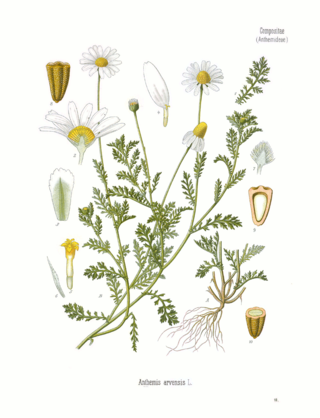
Anthemis arvensis, also known as corn chamomile, mayweed, scentless chamomile, or field chamomile is a species of flowering plant in the genus Anthemis, in the aster family. It is used as an ornamental plant.
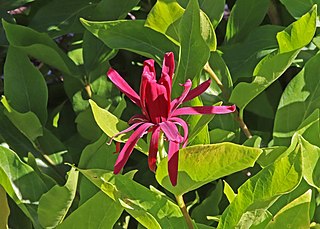
Calycanthus occidentalis, commonly called spice bush or western sweetshrub, is a species of flowering shrub in the family Calycanthaceae that is native to California and Washington state. It grows along streams and moist canyons in the foothills of mountains.

Ribes bracteosum, the stink currant, is a species of currant native to western coastal North America from southeastern Alaska to Mendocino County in California.
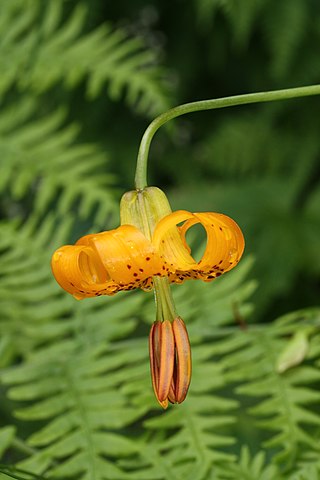
Lilium columbianum is a lily native to western North America. It is also known as the Columbia lily, Columbia tiger lily, or simply tiger lily.

Juncus bufonius, known commonly as toad rush, is a widespread flowering plant species complex in the rush family Juncaceae.

Cirsium occidentale, with the common name cobweb thistle or cobwebby thistle, is a North American species of thistle in the family Asteraceae.

Encelia californica is a species of flowering plant in the family Asteraceae known by the common name California brittlebush. It is also commonly referred to as California coast sunflower and California bush sunflower.

Gaillardia aristata is a North American species of flowering plant in the sunflower family, known by the common names common blanketflower and common gaillardia. This perennial wildflower is widespread across much of North America, from Yukon east to Québec and south as far as California, Arizona, Illinois, and Connecticut, although it may be naturalized rather than native in parts of that range. It is also naturalized in scattered locations in Europe, Australia, and South America.

Tripleurospermum maritimum is a species of flowering plant in the aster family commonly known as false mayweed or sea mayweed. It is found in many coastal areas of Northern Europe, including Scandinavia and Iceland, often growing in sand or amongst beach pebbles.

Sagittaria sanfordii is an uncommon species of flowering plant in the water plantain family known by the common names valley arrowhead and Sanford's arrowhead that is endemic to California.

Artemisia cana is a species of sagebrush native to western and central North America; it is a member of the sunflower family. It is known by many common names, including silver sagebrush, sticky sagebrush, silver wormwood, hoary sagebrush, and dwarf sagebrush.
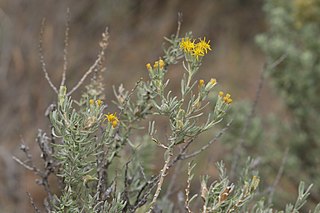
Tetradymia argyraea is a species of flowering plant in the aster family known by the common names spineless horsebrush and gray horsebrush. It is native to western North America.
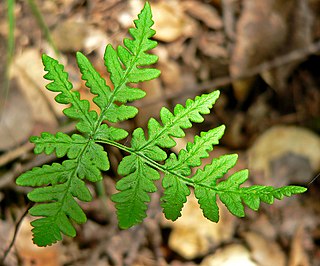
Pentagramma triangularis, commonly known as the gold fern or the goldback fern, is a species of fern in the family Pteridaceae, native to Western North America, with highest abundance in the state of California. Its common name "goldback" refers to the light yellow color of the fern's protective coating which inhibits moisture loss. The gold texture appears as a dry powder that is excreted on the underside of the fern. The Latin specific epithet Pentagramma derives from "five lines" or "stripes" while triangularis derives from "three sided", describing the shape of the fern's broad triangular fronds.

Erigeron filifolius is a North American species of flowering plants in the family Asteraceae known by the common names thread-leaf fleabane.
Helianthus heterophyllus is a species of sunflower known by the common names variableleaf sunflower and wetland sunflower. It is native to the coastal plain of the southern United States from Texas to North Carolina.



















